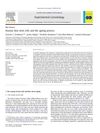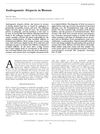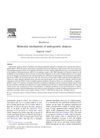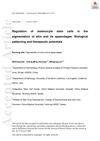TLDR Researchers created a cell line from a hair follicle to study hair loss.
The study established a human dermal mesenchymal-like stem cell line from a scalp biopsy of an androgenetic alopecia patient. These cells, termed "Human Dermal Mesenchymal-like Stem Cells (hDMSCs)," were derived from the bulge region of hair follicles and exhibited both epithelial and mesenchymal characteristics, expressing markers such as CD34, Keratin 18, Oct4, Nanog, and SOX2. The optimal growth conditions for these cells were found to be at a 3% serum concentration. The hDMSCs were maintained up to passage 10 and were proposed as an in vitro model to study the mechanisms of alopecia and related skin disorders.
 235 citations
,
January 2011 in “Journal of Clinical Investigation”
235 citations
,
January 2011 in “Journal of Clinical Investigation” Men with baldness due to androgenetic alopecia still have hair stem cells, but lack specific cells needed for hair growth.
 222 citations
,
August 2009 in “Experimental Dermatology”
222 citations
,
August 2009 in “Experimental Dermatology” Stem cells are crucial for wound healing and understanding their role could lead to new treatments, but more research is needed to answer unresolved questions.
 143 citations
,
September 2008 in “Experimental gerontology”
143 citations
,
September 2008 in “Experimental gerontology” Skin aging is due to impaired stem cell mobilization or fewer responsive stem cells.
 139 citations
,
June 2003 in “Journal of Investigative Dermatology Symposium Proceedings”
139 citations
,
June 2003 in “Journal of Investigative Dermatology Symposium Proceedings” Androgenetic alopecia in women needs more research and better management strategies.
561 citations
,
April 2003 in “Journal of Investigative Dermatology”  229 citations
,
August 2002 in “Experimental Gerontology”
229 citations
,
August 2002 in “Experimental Gerontology” AGA causes hair loss by shrinking hair follicles due to DHT binding, and can be treated with finasteride and minoxidil.
 41 citations
,
December 2018 in “Experimental Dermatology”
41 citations
,
December 2018 in “Experimental Dermatology” Understanding how melanocyte stem cells work could lead to new treatments for hair graying and skin pigmentation disorders.
4 citations
,
January 2013 in “Stem cell discovery” Researchers created a cell line from a hair follicle to study hair loss.







